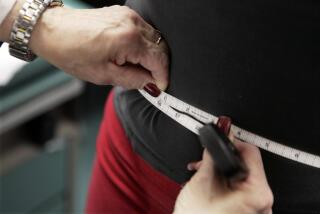42% of American adults will be obese by 2030, study says
The ranks of obese Americans are expected to swell even further in the coming years, rising from 36% of the adult population today to 42% by 2030, experts said Monday.
Kicking off a government-led conference on the public health ramifications of all those expanding waistlines, the authors of a new report estimated that the cost of treating those additional obese people for diabetes, heart disease and other medical conditions would add up to nearly $550 billion over the next two decades.
The sobering projections also contained some good news, the researchers said: Obesityâs growth has slowed from the record pace of most of the last 30 years. If those trends were to continue, 51% of American adults would qualify as obese in 2030.
Study leader Eric Finkelstein, a health economist at Duke University in Durham, N.C., said it was unclear whether growth had slowed thanks to public policy initiatives aimed at preventing childhood obesity, greater societal awareness of obesityâs health risks, or because Americans have hit the maximum level of fatness a population can sustain.
Whatever the reasons, further small successes in anti-obesity efforts â more effective weight-loss drugs, public health campaigns to encourage exercise and more-healthful eating, or workplace health promotion policies â could flatten the curve even more, Finkelstein said at the second annual Weight of the Nation conference in Washington, sponsored by the Centers for Disease Control and Prevention.
âEven small improvements in obesity prevalence ... could result in substantial savings,â he and his colleagues concluded in their report, which was published online Monday by the American Journal of Preventive Medicine.
The forecast took into account a host of factors thought to influence Americansâ eating and exercise habits, including the cost of groceries, the prevalence of restaurants, the unemployment rate, Internet access and the price of gas.
Most important was the aging of the population, which tends to nudge many overweight adults into the obese category â and to push many of those who are already obese into âseverely obeseâ territory. The number of severely obese Americans is expected to grow from about 5% today to 11% in 2030, the study said.
The findings are based on data collected from 1990 through 2008 as part of the Behavioral Risk Factor Surveillance System, a survey by the CDC and health departments in the states. Measures of obesity were based on body mass index, which is calculated as weight in kilograms divided by height in meters squared. A BMI of 18 to 24.99 is considered healthy; those in the 25-29.99 range are considered overweight; people above 30 are classified as obese, and those above 40 are severely obese.
In January, two CDC studies suggested that obesity rates were stabilizing at 17% for children and 35% for adults. That was based on data from the National Health and Nutrition Examination Survey.
The Weight of the Nation conference brings together 1,200 experts from around the country. A centerpiece will be the airing of portions of a four-part documentary with the same name that was produced by HBO and the Institute of Medicine, with support from the CDC, the National Institutes of Health, Kaiser Permanente and the Michael and Susan Dell Foundation.
When the documentary airs on HBO next week, it may be a rude shock for Americans whose nightly ritual involves grabbing a snack and escaping to a televised world without fat people while junk-food advertisements wash seductively and insistently over them.
Viewers will meet women who instinctively straighten their tops over their middles as they sit and men whose beefy chests have risen to fill their shoulders, chins and cheeks. They recount how they came to fill their XXL clothes, how their knees hurt and where they are in their slide toward Type 2 diabetes. And they demonstrate how hard it is, once fat, to get unfat.
If the next generation is to be saved from obesity, the documentary makes clear, it will take an extraordinary confluence of biological, economic and social forces setting aside narrow imperatives to do whatâs right.
Public health experts have concluded that the best way to attack the obesity crisis is to prevent people from becoming obese in the first place. They place a particular emphasis on children, based on a statistic that emerged from the landmark Bogalusa Heart Study: 77% of obese children become obese adults, while only 7% of non-obese children do.
For weight gain to be averted â let alone reversed â policymakers would have to move beyond politically palatable initiatives such as removing sugary sodas from schools and planting community gardens in urban food deserts, said Robert Jeffery, an epidemiologist and weight-loss researcher at the University of Minnesota. Very likely, junk food would have to be taxed to discourage consumption, and advertising for those products would have to be prohibited, he said.
But itâs not clear that even these draconian measures would help, Jeffery said. Boosting access to fresh fruits and vegetables in low-income communities did not reduce overall caloric consumption in a recent study because people didnât scale back their intake of familiar high-fat snack foods to compensate for the new foods.
By adulthood, obesity has already set in motion many of its most devastating health effects. At that point, neither exercise nor the loss of 5% to 10% of body weight is likely to move patients from the obese side of the nationâs ledger.
Journal after journal have reported disappointing results for programs to help obese adults lose weight. And an estimated 80% of American dieters regain their lost weight, causing many to end up more flabby than when they started. In a study published this year in Archives of Internal Medicine, researchers wearily admitted that a more realistic goal than substantial weight loss might be to get obese adults to stop gaining, and to whittle their waist sizes modestly â which can at least improve metabolic function.







